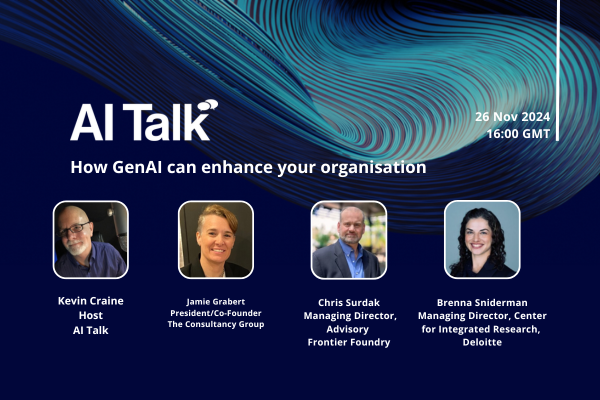Content management and the AI revolution

Michael Lukaszczyk at Hygraph explains why it’s time to future-proof the content management system
Generative AI (GenAI) promises to transform industries as diverse as coding and customer service. Research reveals that three-quarters of organisations believe it will lead to “significant” or “disruptive change” in the coming years. But at heart, GenAI is about creating (and summarising) content. So, the content economy arguably gains the most from its rapid rise.
Organisations hoping to use GenAI to supercharge their content strategies must integrate the technology effectively into their CMS. Yet, given that 84% already feel their CMS is holding them back from unlocking the actual value of their content, this will be easier said than done. With this in mind, it pays to understand first how GenAI will potentially transform the content management space.
Concerns and opportunities
The adoption rate of GenAI is astonishing. A recent McKinsey study revealed that 65% of global organisations regularly use it, nearly double the share from a similar survey just 10 months previously.
But when it comes to incorporating the technology into CMS strategy, there are a few warning signs. Research reveals that many organisations are struggling to extract value from their platforms. Some 92% claim it’s challenging to deliver content from different sources to multiple channels, for example. And 80% are worried about how to future-proof their CMS. Their concerns are valid. But what about the opportunities?
Doing the basics
GenAI is most commonly discussed in relation to pure content creation. The combination of intelligent algorithms and natural language processing (NLP) gives models the unerring ability to generate convincing copy, as if it were written by a native-speaking human. Automating a formerly time-consuming process while increasing accuracy could free marketers and others to focus on more strategic tasks. For those who want to retain control over the creative process, it could at least help shift writer’s block.
GenAI could also play a role in curating content and managing the content lifecycle through publication and archival, including image generation and product descriptions, further boosting worker productivity. Yet this is a fairly low-level use case for GenAI. There are more valuable ways the technology could be integrated into content management, starting with the benefits of development work.
Easing the developer bottleneck
When it comes to CMS development, organisations have historically suffered from an innovation bottleneck. Some 88% of organisations cite this as a problem because they’ve got to build custom middleware and maintain integrations to expose data and content in digital services, for example.
Front-end application development can also add significant time and cost, meaning organisations can’t expose content to their customers. It’s like having a fully electrically powered home with no devices to connect to it. This is a massive area for improvement as a shortage of app developers and the complexity of the task can leave many brands unable to share content with their customers and prospects effectively.
But here’s the good news: GenAI can generate code to reduce the development time needed greatly. Yes, human expertise will still be required to write the prompts and review the code. But it will significantly streamline the process. It’s all part of a macro trend whereby we’re likely to see the developer of the future more akin to an AI engineer than their current role today.
The groundwork for content schemas
Although less of a bottleneck, creating content schemas is also a job for highly specialised talent like programmers or experts in data modelling. A content schema is a structured framework that defines the organisation’s structure and the elements of content within a system. This is a critical task designed to ensure consistency, standardisation, SEO optimisation, and easier content management, among other things.
However, as content grows and becomes more dynamic, and the number of channels it’s published to increases, the process becomes ever more complex.
As a result, it’s becoming an increasingly time- and labour-intensive task. But AI can provide a productivity boost by rapidly improving the speed at which content schemas can be created and updated.
Questioning your content
Perhaps the most compelling use case for GenAI in a CMS context is enabling users and customers to query and search content via natively integrated AI-powered chatbots. It’s about going beyond traditional search to create a customer service tool that returns highly accurate and relevant information via natural language queries/prompts.
Whether finding product information or creative content like blogs, this could help drive sales, build loyalty, and enhance the customer experience. The chatbot could also suggest related content to personalise the experience.
A headless future
Content velocity and variety are increasing exponentially. GenAI offers several ways to stay ahead of the competition, shortening development time, enhancing the customer experience, and helping to manage the content lifecycle.
But if organisations want to realise these benefits, they will need a headless CMS that uses APIs for platform-independent content distribution and integrates seamlessly with local language models (LLMs).
The value of APIs will only increase in the new era of GenAI. The focus for CMS development will increasingly be not on visual UX platforms (for humans) but rather on technical interfaces that work better with AI and underlying code. Humans are still crucial to content management. But increasingly, so too are AI models.
![]()
Michael Lukaszczyk is CEO and Co-Founder of Hygraph
Main image courtesy of iStockPhoto.com and Worawee Meepian

Business Reporter Team
Most Viewed
Winston House, 3rd Floor, Units 306-309, 2-4 Dollis Park, London, N3 1HF
23-29 Hendon Lane, London, N3 1RT
020 8349 4363
© 2024, Lyonsdown Limited. Business Reporter® is a registered trademark of Lyonsdown Ltd. VAT registration number: 830519543





